
The Cyclops Cave lies in the southern part of the rocky and hostile
island of Yioura. Yioura belongs to the island group of the north Sporades,
about 20 miles from Alonnisos.
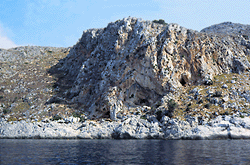
The Cyclops Cave is situated 150 metres above the sea level and its
size (60X50) and height (15 m) makes it the biggest in the north Sporades.
Excavations conducted in its interior (1992-95) have provided evidence
of continuous human activity from the Mesolithic
Period (10,000-6,800 BC) throughout the Preceramic Neolithic
(6800-6500 BC), up to the Late Neolithic Period II (LÍ II) and the beginning
of the Final Neolithic (4600/4500-3300/3200 BC). The cave was used also
during Historic times (Classic-Roman Period).
The sections excavated at the mouth of the cave unearthed anthropogenic layers rich in stone and bone artefacts, ceramics, animal and fish bones and shells.
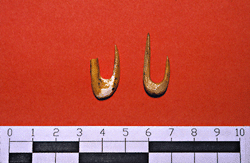
Evidence from the layers of the Mesolithic period at a depth of 1,8 m suggests that the cave was used intensively during this period and this find is particularly important for the Aegean Prehistory. Stones and animal bones confirm that hunting was practised, whereas the plant remains and many shells and snails provide evidence of continuous gathering. Hundreds of fish bones mainly of tuna, and a number of fishooks (approximately 45) in different sizes (6 mm-7 mm) indicate that intensive fishing with advanced tool equipment took place.
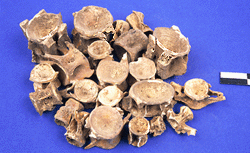
Since this marine location is still a passage for tuna mainly in autumn,
it is possible that the Cyclops Cave was inhabited periodically by specialized
fishermen from neighboring islands which were intensively populated
during the 9th-7th millenium BC (Alonnisos).
At the beginning of the Holocene
travelling from one island to another along sea passages was probably
conducted by primitive means (rafts). Navigation is attested in the
Aegean in the middle of the 9th millenium by the artefacts of Melian
obsidian
found at Franchthi Cave in Hermionid.
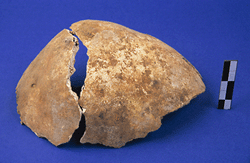
At the Cyclops Cave, in layers of the 9th millenium, part of a woman's
skull was found whose age has not yet been definitely determined. Anthropological
material date to the Mesolithic period are also known from burials which
were found at caves in Attica, at Franchthi in Hermionid, at Theopetra
in Kalambaka and at Maroulas
on Kythnos.
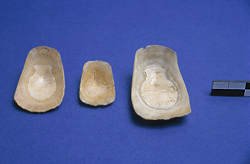
Among the finds of the Mesolithic, shell-ornaments and limpet shells,
which were turned into spoons after special retouch, were discovered.